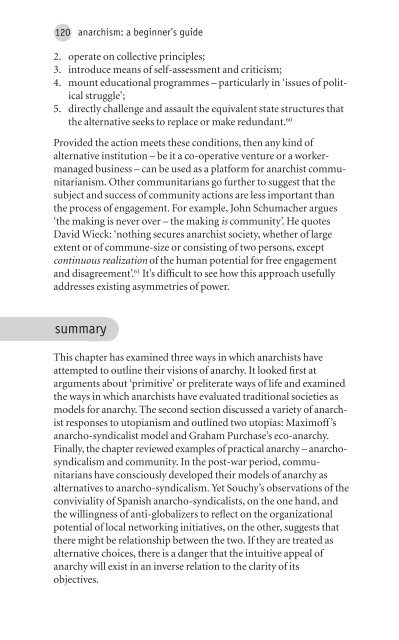o_195qg5dto17o4rbc85q1ge61i84a.pdf
Create successful ePaper yourself
Turn your PDF publications into a flip-book with our unique Google optimized e-Paper software.
120<br />
anarchism: a beginner’s guide<br />
2. operate on collective principles;<br />
3. introduce means of self-assessment and criticism;<br />
4. mount educational programmes – particularly in ‘issues of political<br />
struggle’;<br />
5. directly challenge and assault the equivalent state structures that<br />
the alternative seeks to replace or make redundant. 60<br />
Provided the action meets these conditions, then any kind of<br />
alternative institution – be it a co-operative venture or a workermanaged<br />
business – can be used as a platform for anarchist communitarianism.<br />
Other communitarians go further to suggest that the<br />
subject and success of community actions are less important than<br />
the process of engagement. For example, John Schumacher argues<br />
‘the making is never over – the making is community’. He quotes<br />
David Wieck: ‘nothing secures anarchist society, whether of large<br />
extent or of commune-size or consisting of two persons, except<br />
continuous realization of the human potential for free engagement<br />
and disagreement’. 61 It’s difficult to see how this approach usefully<br />
addresses existing asymmetries of power.<br />
summary<br />
This chapter has examined three ways in which anarchists have<br />
attempted to outline their visions of anarchy. It looked first at<br />
arguments about ‘primitive’ or preliterate ways of life and examined<br />
the ways in which anarchists have evaluated traditional societies as<br />
models for anarchy. The second section discussed a variety of anarchist<br />
responses to utopianism and outlined two utopias: Maximoff’s<br />
anarcho-syndicalist model and Graham Purchase’s eco-anarchy.<br />
Finally, the chapter reviewed examples of practical anarchy – anarchosyndicalism<br />
and community. In the post-war period, communitarians<br />
have consciously developed their models of anarchy as<br />
alternatives to anarcho-syndicalism. Yet Souchy’s observations of the<br />
conviviality of Spanish anarcho-syndicalists, on the one hand, and<br />
the willingness of anti-globalizers to reflect on the organizational<br />
potential of local networking initiatives, on the other, suggests that<br />
there might be relationship between the two. If they are treated as<br />
alternative choices, there is a danger that the intuitive appeal of<br />
anarchy will exist in an inverse relation to the clarity of its<br />
objectives.




